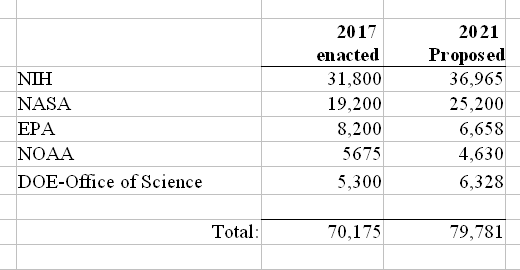Senate fails to fully fund manned lander for Trump’s 2024 lunar mission
The Senate appropriations committee’s budget recommendations for NASA, released yesterday, has refused to fully fund the development of the manned lander needed for Trump’s 2024 lunar mission.
The Senate Appropriations Committee released its recommendations for all 12 FY2021 appropriations bills today. The Commerce-Justice-Science (CJS) bill provides NASA with $23.5 billion, $1.75 billion less than requested. The House-passed bill keeps the agency at its current level of $22.6 billion, so the final compromise likely will be somewhere in that range. NASA’s request for Human Landing Systems (HLS) for the Artemis program was particularly hard hit on both sides of Capitol Hill.
NASA had requested $3.4 billion for building the lunar lander in time for 2024. The House appropriated $628 million. Today’s Senate recommendation budgeted $1 billion. This practically guarantees that no manned lunar mission will happen by 2024.
None of this is a surprise. The politicians in Congress from both parties don’t really want to rush this program. For them it is better to stretch it out for as long as possible, spending mucho bucks in their states and districts. Nothing will be accomplished, but they will be able to tell their constituents they brought the jobs home.
Useless and empty jobs, but jobs nonetheless.
The Senate appropriations committee’s budget recommendations for NASA, released yesterday, has refused to fully fund the development of the manned lander needed for Trump’s 2024 lunar mission.
The Senate Appropriations Committee released its recommendations for all 12 FY2021 appropriations bills today. The Commerce-Justice-Science (CJS) bill provides NASA with $23.5 billion, $1.75 billion less than requested. The House-passed bill keeps the agency at its current level of $22.6 billion, so the final compromise likely will be somewhere in that range. NASA’s request for Human Landing Systems (HLS) for the Artemis program was particularly hard hit on both sides of Capitol Hill.
NASA had requested $3.4 billion for building the lunar lander in time for 2024. The House appropriated $628 million. Today’s Senate recommendation budgeted $1 billion. This practically guarantees that no manned lunar mission will happen by 2024.
None of this is a surprise. The politicians in Congress from both parties don’t really want to rush this program. For them it is better to stretch it out for as long as possible, spending mucho bucks in their states and districts. Nothing will be accomplished, but they will be able to tell their constituents they brought the jobs home.
Useless and empty jobs, but jobs nonetheless.



